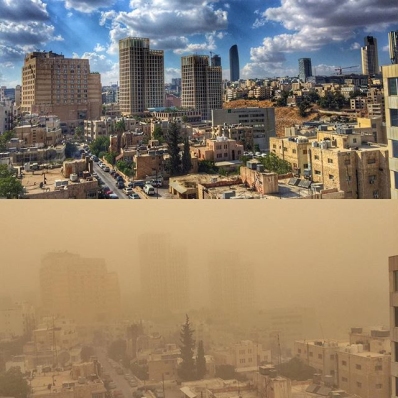 By Miranda Morton
By Miranda Morton
AMMAN— On a Tuesday morning, two weeks after my arrival in Amman, a sandstorm settled over the city. The weather forecast on my iPhone, which read “Hazy” and “Dust,” surprised me, but could not have described the floating particulate matter outside more perfectly. I had gotten into the habit of walking to school, so my host mom made a point of telling me to either wear a protective mask or take a taxi. I felt silly with the surgical-style mask in my hand, so I opted for a taxi.
Initially I thought this was a relatively normal occurrence — Jordan is basically a desert, so a sandstorm makes sense, right? In all reality, however, sandstorms of the magnitude that descended over the Levant at the beginning of September are extremely rare occurrences. This meteorological enigma engenders many questions regarding anthropogenic change and its palpable effects on human society.
Because dramatic news of failed states and extremist groups dominate the Middle East headlines of American media, the region’s environmental problems are often overlooked. Don not be fooled though; understanding the relationship between the environment and current events is crucial. For example, substantial evidence now links the civil war in Syria to a severe drought that happened between 2007-2010. The drought, which caused pervasive crop failure and mass migration, was the worst in Syria’s modern recorded history.
For environmentalists, the correlations between climate change, especially water scarcity, and social unrest continue to multiply. Of course, there are many factors that contribute to the outbreak of political conflict, but an acute lack of water resources compounds ineffective governance and civil unrest. Many organizations are working to mitigate the problems associated with climate change and address water crises throughout the Middle East.
This past week, I had the opportunity and pleasure to visit a unique environmental non-governmental organization called EcoPeace Middle East and interview the regional deputy director. The main objective of EcoPeace is to promote cooperative efforts between Jordan, Israel and Palestine that confront the region’s water issues. While a popular call to action among governments and international institutions is to invest billions into state-of-the-art infrastructure such as the Red Sea Dead Sea mega-project, EcoPeace advocates for water-interdependency between the three states and the rehabilitation of the Jordan River, which has been wrecked from decades of pollution and water diversion.
EcoPeace’s aspirations are of the highest order, considering the political climate of the world’s “most intractable conflict.” However, a water settlement may be an important step in long-term stability and security in the region. Moreover, from a Jordanian perspective, a water settlement may be the only option in meeting the country’s water needs in the coming decades.
Jordan is already considered one of the most water scarce countries in the world. On average, the country’s annual per person water share is 145 cubic meters (the average American enjoys 900 cubic meters of water annually). With climate change affecting the water cycle and a growing refugee crisis, Jordan’s per-person water share is expected to fall to 90 cubic meters by 2025.
Speaking from my personal experiences this past month, Jordanians are well aware of the long-term implications of water scarcity, and they take great measures to conserve and reuse water. However, the sandstorm that hit Amman and the Levant this past month reflects the more immediate concerns of climate change. As policy-makers and researchers continue to develop various peace-building frameworks for the Middle East, attention to the water crisis and sustainable environmental practices must remain bedrock principles.
